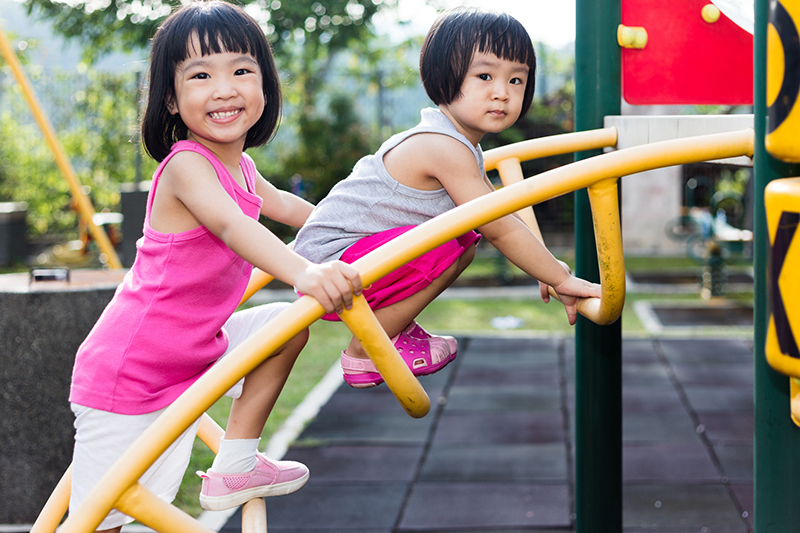Families For Life | What did Simon Say?

As parents, you may have come across the terms gross motor skills and fine motor skills. These are two distinct skill sets your child will develop over the course of his early years.
Gross motor skills refer to the ability to control and coordinate large muscle movements. These specifically involve the arms, legs and body. Sitting, hopping, bending, running, jumping and climbing all require gross motor skills.
Fine motor skills refer to the ability to control and coordinate small muscle movements. Feeding himself using a spoon, grasping a pencil, scribbling, colouring, picking up a small object and the more advanced activity of tying his shoelaces and buttoning a shirt all require fine motor skills. The development of hand and finger strength paves the way for writing, an important skill needed for the formal school-going years.
Note that the large muscles of a three-year-old will develop ahead of the small muscles. As a result, your youngster will find it easier to walk, jump and climb than to grip a pencil and draw a line. Often, parents will find that their child learns to run and jump before mastering the ability to hold a pencil/crayon the right way. Rest assured that this sequence of development is developmentally appropriate.
Activities for developing gross motor skills can enhance the development of fine motor skills. For instance, in the simple act of throwing and catching a ball, a child works those gross motor skills by running, jumping and bending. He also develops hand-eye coordination, which is the ability for the eyes to guide the hands.
Parents could provide ample opportunities to encourage their children to work on their motor skills. You’ll need a safe, open space like a park or playground (so your little one has freedom to move), imagination, patience and some basic equipment. Adult supervision is a must, of course, while having other children of similar age to interact and play with only ups the fun factor.
Remember that all children develop at their individual pace. If your child is not ready for a particular activity, don’t rush him into it. Pick appropriate activities that matches his interests and capabilities. The following are some activities aimed at developing hand-eye coordination, balancing and gross motor skills. Parents can adapt the activities to suit their needs and surroundings. Consider minimally structured games so you can be flexible in the execution.
Simon says
This game is best played with a group of children, but it can work with one child, too. One parent takes on the role of ‘Simon’ and stands facing the children. The aim of the game is for players to follow instructions that only begin with ‘Simon says’. Now, Mum and Dad, it’s up to you to fill the game with giggly fun. Begin with simple instructions like, “Simon says, jump in the air!” As the children follow your instructions, check they’ve got it right and praise their ability. Continue the game with wacky instructions like, “Simon says, stand on one foot and touch your nose!” Or “Simon says, squat on the ground and waddle in a circle.” When everyone is busy laughing and having fun, see how attentive they are by instructing, “Put your hands on your head.” Those that follow this instruction will be out of the game as it did not begin with ‘Simon says’. The last child standing is the winner.
Get little ones moving with instructions like, “Simon says, wriggle your hips,” or “Simon says, hop like a frog!” Substitute “Simon says” with “Daddy says” or “Teddy says”. Use your creativity to make the game more interesting and relevant to your junior players. When children are following an instruction like standing on one foot or squatting, they are learning how to balance their bodies; when they jog on the spot or swing their arms, they’re working on their gross motor skills, which strengthen muscles. By asking them to scratch their heads like a monkey or rub their tummies (while standing on one foot!), they exercise their fine motor skills (hand and finger muscles) as well as develop their sense of balance.
Balloon fun
Blow up some balloons in different colours, hit them in the air with your hand and encourage your preschooler to do the same. See how long he can keep the balloon in the air by hitting it upwards or forwards. This activity helps a child develop hand-eye coordination and movement skills as he chases the balloon across a safe, open space.
Playing ball
Another easy way to develop hand-eye coordination is by sitting on the ground and rolling a ball to your child who has to catch and roll it back to you. With older preschoolers, you can throw a ball for them to catch and toss it back to you. The aim is to get those arms, legs and visual-tracking skills on the go!
Sock it
This game, which encourages hand-eye coordination among a range of movement skills, works with a group of children; you will need a pair of rolled-up adult socks. Get players to form a circle with one child standing in the center. Each child in the circle takes turns throwing the sock ball at the child in the middle, who must try and dodge the (soft) flying missile. Do remind the children to throw it gently to prevent mishaps. When the child in the middle gets hit, he changes place with the child whose aim hit its target.
Explore more
- Let's all move it, move it
- Outdoor play
- Physical activity for younger children
- Play outside (0-6 years)
- Playing with balls (3-6 years)
Contributed by:
Early Childhood Development Agency